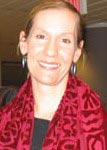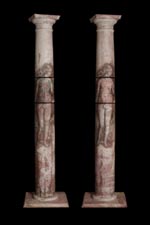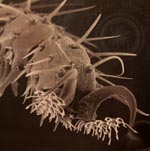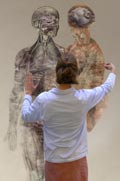
This web page is part of the Michigan Today Archive. To see this story in its original context, click here.
A gallery talk by artist Patricia OlynykFor more information about Patricia Olynyk, see http://art-design.umich.edu/faculty/olynyk/
Patricia Olynyk, assistant professor of art, is currently exploring, in a series of exhibits, how the imagery derived from systems of scientific classification 'enhance and obscure knowledge.' To that end, Olynyk has produced a series of works that comprise traditional prints and sculptures, interactive cyberspace media, scanning electron micrographs, schematized bodies, labyrinth gardens, hybrid species and 'chimaeric [imaginary] creatures.' 'This grouping combines art, human culture, science and technology,' explains Olynyk, a 1983 graduate of the Alberta College of Visual Arts in Alberta, Calgary, Canada, who earned her MFA in printmaking in 1988 at the California College of the Arts in San Francisco and Oakland. The series of Olynyk's works in our NewsE gallery represent a small sample of her projects. We adapted the following commentary from Olynyk's lecture on her work.
As Adam, Durer engraved a likeness of Alberti, and to represent Eve he used his own face. In the same commemorative spirit, I used Durer's Eve, (really Durer himself), to celebrate Lilith, who, according to Hebraic tradition, was cast out of Eden to spend the rest of her days by the Red Sea, frolicking with demons and producing hybrid offspring. I collaborated with U-M professor and particle physicist Dante Amidei to create this sculpture: Particle Paradise , or Lilith Looking for a Particle of Another Charge. Here, Lilith exists in both her visceral and particle forms. The sculpture is interactive and the viewer is invited to rotate the central section of the pillar to contemplate her in both her incarnations. The image on the right shows Lilith with overlays of photographic film from the Fermi Lab, which traces the trajectories and collisions of particle matter.
My Many Pleasure Garden installation, which will be shown at the National Academy of Sciences in Washington next year, combines macro photographs of Japanese gardens that are meant to 'tickle the senses,' with microscopic images of bodily sites of sensation. The giant taste bud offers a marvelous display of radial symmetries. This work, an image of the feet of the Drosophila fruit fly, is also part of my solo exhibition for the National Academy of Sciences, the Cenesthesia series, and specifically the Cenesthesia: Touch portion. Cenesthesia refers to 'the general feeling of inhabiting one's body that arises from multiple stimuli from various bodily organs' ( Merriam-Webster Medical Dictionary ). In addition to the fly, images of other scientific specimens include human corneas (representing sight), wild mouse taste buds and olfactory epithelia (representing taste and smell), guinea pig cochlea (for sound) and, as shown here, drosophila feet (for touch). This eclectic array deliberately mixes species to stress that the nature of being sensate is not uniquely human.
A small bubbling fountain marks the center of the plaza, and a reflecting pool circumvents the central platform. A labyrinth poem visible to wanderers once they reach center will read in both English and Latin: INFINITE.PATTERN.AND.TANGIBLE.WHOLE. UNFOLDING.PATHS.TO.THE.UNFETTERED.SOUL.
Microphotographs of my own body, histological samples and imagery drawn from the collections at the Exhibit Museum of Natural History are the source material for my Ars Combinatoria, a work in progress funded in part by the Office of the Vice President for Research. Like the traditional flap-anatomy, this project involves touch sensitivity, only in this case the viewer/participant will be opening a body projected on a special mist called a 'fog wall.' It includes morphologies that blend my own image with images of other creatures, including imaginary creatures, or chimaera, like the Fiji mermaid and merman and other anomalous inventions of the mind that many Renaissance scientists believed to exist. Flipping through the various layers will produce different narrative pathways that will take the participant through a guided journey through labyrinthine spaces and ambiguous environments. In the process, the specimen/subject will be prompted to sprout chimaeric limbs or to morph, encouraging the participant to think about the boundaries where the body ends and 'embodiment' begins. |
|
Michigan Today News-e is a monthly electronic publication for alumni
and friends. |
| MToday NewsE | |
|
|
Michigan Today
online alumni magazine
University Record
faculty & staff newspaper
MGoBlue
athletics
News Service
U-M news
Photo Services
U-M photography
University of Michigan
gateway

 In 1504, Albrecht Durer completed an engraving of 'Paradise' to commemorate Leon Battista Alberti, who is credited with having written a spellbinding synthesis of art and science in 1499, the Hypner—oto—machia Po—li—phi—li , a dreamlike text considered to be one of the most enigmatic books ever conceived.
In 1504, Albrecht Durer completed an engraving of 'Paradise' to commemorate Leon Battista Alberti, who is credited with having written a spellbinding synthesis of art and science in 1499, the Hypner—oto—machia Po—li—phi—li , a dreamlike text considered to be one of the most enigmatic books ever conceived. 

 In 2000, the U-M Matthaei Botanical Gardens approached me to design a large-scale public artwork - a Labyrinth. My design draws primarily on mathematical source material, specifically the growth patterns of the angel-wing begonia leaf. The labyrinth will span almost 120 feet in length and more than 100 feet in width, including the planted pathways partially flanking the piece on either end. Preparations for the construction of this mammoth, 5,500 square-foot feature garden have involved the efforts of a collaborative team of architects, landscapers, materials engineers and biologists.
In 2000, the U-M Matthaei Botanical Gardens approached me to design a large-scale public artwork - a Labyrinth. My design draws primarily on mathematical source material, specifically the growth patterns of the angel-wing begonia leaf. The labyrinth will span almost 120 feet in length and more than 100 feet in width, including the planted pathways partially flanking the piece on either end. Preparations for the construction of this mammoth, 5,500 square-foot feature garden have involved the efforts of a collaborative team of architects, landscapers, materials engineers and biologists. Like illustrations from the anatomical textbooks of 16 th century artist Andreas Vesalius, 20th- century flap-anatomies are teaching tools that allow the viewer to flip through sequential images of the body.
Like illustrations from the anatomical textbooks of 16 th century artist Andreas Vesalius, 20th- century flap-anatomies are teaching tools that allow the viewer to flip through sequential images of the body.